Today (April 18, 2024), the Australian Bureau of Statistics released the latest - Labour Force,…
Australian labour market – goes backwards again
Today’s release of the – Labour Force data – for December 2015 by the Australian Bureau of Statistics show a labour market in retreat. Total employment growth was a negative (barely) and labour force participation fell marginally. While total unemployment declined, it was only due to the fact that the labour force shrank by more than employment contracted, which means that actual unemployment was substituted for hidden unemployment. The data continues to strain credibility with some quite bizarre monthly shifts. The cautious position is to look at the trend over the last several months and that suggests that the labour market has improved marginally. However, the teenage labour market remains very weak with no discernible upwards trend revealing itself yet. If the forecasted decline in private investment occurs over the next 12 months, then this modest improvement in the labour market over the last six months will not persist.
The summary ABS Labour Force (seasonally adjusted) estimates for December 2015 are:
- Employment decreased 1,000 (0.0 per cent) with full-time employment increasing by 17,600 and part-time employment falling by 18,500.
- Unemployment decreased by 10,900 to 727,500.
- The official unemployment rate decreased by 0.1 percentage points to 5.8 per cent.
- The participation rate decreased 0.1 percentage points to 65.1 per cent. It is still well below its November 2010 peak (recent) of 65.9 per cent.
- Aggregate monthly hours worked increased 0.3 million hours (0.02 per cent).
- The quarterly ABS broad labour underutilisation estimates (the sum of unemployment and underemployment) were updated last month. Underemployment was at 8.4 per cent and total labour underutilisation rate was at 14.3 per cent. There were 1,051.2 thousand persons underemployed and a total of 1.839.3 thousand workers either unemployed or underemployed. The next quarterly release will be in the February 2016 publication.
Employment growth – back to negative again – the zig-zag trend continues
The last two months saw quite dramatic increases in total employment, which somewhat confounded the analysts (such as yours truly) and continued to fuel our suspicion that the Labour Force Survey is delivering some very strange results as a result of the way in which the population benchmarks are revised.
This month we return to the zig-zag pattern that we have observed over the last 24 months or so – where the employment estimates have been switching back and forth regularly between negative employment growth and positive growth with the occasional spikes.
This month total employment fell by 1000, which is nothing at all but in the context of the growth in the previous two months suggests that we are not entering a new phase of labour market prosperity.
The only positive side of today’s data release is that full-time employment continue to grow. Given the season (Xmas) is hard to fathom the decline in part-time employment, which usually is booming that time of year
The following graph shows the month by month growth in full-time (blue columns), part-time (grey columns) and total employment (green line) for the 24 months to December 2015 using seasonally adjusted data.
It gives you a good impression of just how flat employment growth has been over the last 2 years.
The following table provides an accounting summary of the labour market performance over the last six months. The monthly data is highly variable so this Table provides a longer view which allows for a better assessment of the trends. WAP is working age population (above 15 year olds).
The conclusion – overall there have been 190.6 thousand jobs (net) added in Australia over the last six months while the labour force has increased by 165.4 thousand. Employment growth has outstripped the increase in the supply of labour with the result that unemployment has fallen by 25.2 thousand.
Full-time employment has risen by 119.6 thousand jobs (net) while part-time work has risen by 71.3 thousand jobs. Thus, 37.4 per cent of the total employment created (net) over the last 6 months has been part-time.
The participation rate has risen by a substantial 0.4 points from very low levels.
Unemployment has fallen by 25.2 thousand as a result of employment growing by more than the labour force.
The following graph shows employment indexes for the last 3 recessions and allows us to see how the trajectory of total employment after each peak prior to the three major recessions in recent history: 1982, 1991 and 2009 (the latter to capture the current episode).
The peak is defined as the month of the low-point unemployment rate in the relevant cycle and total employment was indexed at 100 in each case and then indexed to that base for each of the months as the recession unfolded.
I have plotted the 3 episodes for 94 months after the low-point unemployment rate was reached in each cycle – the length of the current cycle.
The initial employment decline was similar for the 1982 and 1991 recessions but the 1991 recovery was delayed by many months and the return to growth much slower than the 1982 recession.
The current episode is distinguished by the lack of a major slump in total employment, which reflects the success of the large fiscal stimulus in 2008 and 2009.
However, the recovery spawned by the stimulus clearly dissipated once the fiscal position was reversed and the economy fell back into producing very subdued employment outcomes. The last several months have showed some signs that the pace of employment growth is picking up.
Moreover, since February 2008, employment has grown by a miserly 11.8 per cent, which is a very slow pace in historical terms for such a long period.
Given the variation in the labour force estimates, it is sometimes useful to examine the Employment-to-Population ratio (%) because the underlying population estimates (denominator) are less cyclical and subject to variation than the labour force estimates. This is an alternative measure of the robustness of activity to the unemployment rate, which is sensitive to those labour force swings.
The following graph shows the Employment-to-Population ratio, since February 2008 (the low-point unemployment rate of the last cycle).
It dived with the onset of the GFC, recovered under the boost provided by the fiscal stimulus packages but then went backwards again as the last Federal government imposed fiscal austerity in a hare-brained attempt at achieving a fiscal surplus.
The ratio has been steadily rising since October 2014 which would suggest that the labour market may have bottomed out and will improve slowly as long as there are no major policy contractions or cuts in private capital formation.
The on-going fiscal deficit is still supporting growth in the economy as the spending associated with the mining boom disappears.
The series decreased sharply by 0.1 points in December.
Teenage labour market – goes backward again
The teenage labour market deteriorated in December 2015 with full-time employment falling by 2.7 thousand and part-time employment falling by 1.6 thousand.
Again, I have serious doubts about the veracity of this data. In the previous two months, the ABS reported that the teenage participation rate for 15-19 years jumped by 0.9 points (October) and 0.7 points (November). In December 2015, the estimates show a decline of 0.4 percentage points. These are very large changes in historical terms and difficult to believe.
The teenage unemployment rate fell from 17.5 per cent to 17.2 per cent in December 2015 all because of these weird participation swings (dropping in December – so less teenagers in the labour force).
The following graph shows the distribution of net employment creation in the last month by full-time/part-time status and age/gender category (15-19 year olds and the rest)
If you take a longer view you see how poor the situation remains.
Over the last 12 months, teenagers have gained 20.6 thousand jobs overall while the rest of the labour force have gained 280.7 thousand net jobs. Remember that the overall result represents a fairly poor annual growth in employment.
The teenage segment of the labour market is being particularly dragged down by the sluggish employment growth, which is hardly surprising given that the least experienced and/or most disadvantaged (those with disabilities etc) are rationed to the back of the queue by the employers.
The following graph shows the change in aggregates over the last 12 months. It is as if the teenagers have not had a stake in the labour market either way (blue bars barely visible)
To further emphasise the plight of our teenagers, I compiled the following graph that extends the time period from the February 2008, which was the month when the unemployment rate was at its low point in the last cycle, to the present month (December 2015). So it includes the period of downturn and then the so-called “recovery” period. Note the change in vertical scale compared to the previous two graphs.
Since February 2008, there have been only 1,254.8 thousand (net) jobs added to the Australian economy but teenagers have lost a staggering 89.4 thousand over the same period. It is even more stark when you consider that 100.1 thousand full-time teenager jobs have been lost in net terms.
Even in the traditionally, concentrated teenage segment – part-time employment, teenagers have gained only 10.7 thousand jobs (net) even though 667.1 thousand part-time jobs have been added overall.
Overall, the total employment increase is modest. Further, around 53 per cent of the total (net) jobs added since February 2008 have been part-time, which raises questions about the quality of work that is being generated overall.
To put the teenage employment situation in a scale context the following graph shows the Employment-Population ratios for males, females and total 15-19 year olds since February 2008 (the month which coincided with the low-point unemployment rate of the last cycle).
You can interpret this graph as depicting the loss of employment relative to the underlying population of each cohort. We would expect (at least) that this ratio should be constant if not rising somewhat (depending on school participation rates).
The facts are that the absolute loss of jobs reported above is depicting a disastrous situation for our teenagers. Males, in particular, have lost out severely as a result of the economy being deliberately stifled by austerity policy positions.
In the last month, with the employment situation improving, there has been some reversal in the downward trends in these ratios.
The male ratio has fallen by 10.9 percentage points since February 2008, the female ratio has fallen by 3.7 percentage points and the overall teenage employment-population ratio has fallen by 7.4 percentage points. That is a substantial decline in the employment market for Australian teenagers.
The other staggering statistic relating to the teenage labour market is the decline in the participation rate since the beginning of 2008 when it peaked in January at 61.4 per cent. In December 2015, the participation rate was just 54.2 per cent.
That is an additional 106.3 thousand teenagers who have dropped out of the labour force as a result of the weak conditions since the crisis.
If we added them back into the labour force the teenage unemployment rate would be 26.9 per cent rather than the official estimate for December 2015 of 17.2 per cent. Some may have decided to return to full-time education and abandoned their plans to work. But the data suggests the official unemployment rate is significantly understating the actual situation that teenagers face in the Australian labour market.
Overall, the performance of the teenage labour market remains poor. It doesn’t rate much priority in the policy debate, which is surprising given that this is our future workforce in an ageing population. Future productivity growth will determine whether the ageing population enjoys a higher standard of living than now or goes backwards.
I continue to recommend that the Australian government immediately announce a major public sector job creation program aimed at employing all the unemployed 15-19 year olds, who are not in full-time education or a credible apprenticeship program.
Unemployment – decreased 10,900 thousand
The unemployment rate fell by 0.1 percentage points to 5.8 per cent in December 2015 (on rounded and revised data). The decline in unemployment by 10,900 was all due to the decline in the participation rate, given that employment growth was negative.
Overall, the labour market still has significant excess capacity available in most areas and what growth there is is not making any major inroads into the idle pools of labour.
The following graph shows the national unemployment rate from February 1978 to December 2015. The longer time-series helps frame some perspective to what is happening at present.
After falling steadily as the fiscal stimulus pushed growth along, the unemployment rate slowly trended up for some months.
It is now above the peak that was reached just before the introduction of the fiscal stimulus. In other words, the gains that emerged in the recovery as a result of the fiscal stimulus in 2009-10 have now been lost.
Broad labour underutilisation – upwards of 14.3 per cent
The ABS published its quarterly broad labour underutilisation measures for the November-quarter in last month’s data release. So the following reflects the results for that quarter.
In the November-quarter, total underemployment remained at 8.4 per cent and the ABS broad labour underutilisation rate (the sum of unemployment and underemployment) was 14.3 per cent.
| There were 1,058.4 thousand persons underemployed and a total of 1,797.5 thousand workers either unemployed or underemployed. |
The following graph plots the history of underemployment in Australia since February 1978 to the November-quarter 2015.
If hidden unemployment is added to the broad ABS figure the best-case (conservative) scenario would see a underutilisation rate well above 16 per cent at present. Please read my blog – Australian labour underutilisation rate is at least 13.4 per cent – for more discussion on this point.
The next update will be for the February-quarter 2016 and will be published published in the March 2016 Labour Force release.
Aggregate participation rate – falls by 0.1 points
The December 2015 participation rate fell by 0.1 points to 65.2 per cent (on rounded and revised data). Even so, it remains substantially down on the most recent peak in November 2010 of 65.9 per cent when the labour market was still recovering courtesy of the fiscal stimulus.
The official unemployment rate, which fell by 0.1 points this month, would have actually risen given the negative employment growth had not the participation rate fell.
The labour force is a subset of the working-age population (those above 15 years old). The proportion of the working-age population that constitutes the labour force is called the labour force participation rate. Thus changes in the labour force can impact on the official unemployment rate, and, as a result, movements in the latter need to be interpreted carefully. A rising unemployment rate may not indicate a recessing economy.
The labour force can expand as a result of general population growth and/or increases in the labour force participation rates.
What would have the unemployment rate been had the participation rate not fallen by 0.1 points?
The following Table shows the breakdown in the changes to the main aggregates (Labour Force, Employment and Unemployment) and the impact of the decline in the participation rate.
In December 2015, the decline in employment of 1 thousand (net) jobs was accompanied by a decline in the labour force of 11.9 thousand. As a result, unemployment decreased by 10.9 thousand.
The declining labour force in December 2015 was the outcome of two separate factors:
- The underlying population growth added 14.6 thousand persons to the labour force. The population growth impact on the labour force aggregate is relatively steady from month to month but has slowed in recent months; and
- The decline in the participation rate meant that there were 26.5 thousand extra workers leaving the labour force (relative to what would have occurred had the participation rate remained unchanged).
- The net result was the decline in the labour force of 11.9 thousand.
If the participation rate had not have fallen, total unemployment, at the current employment level, would have been 754 thousand rather than the official count of 727.51 thousand as recorded by the ABS – a difference of 26.5 thousand workers (the ‘participation effect’).
Thus, without the decline in the participation rate, the unemployment rate would have been 6 per cent (rounded) rather than its current value of 5.8 per cent.
The conclusion is that hidden unemployment rose in December 2015 while official unemployment rate fell by 0.1 points.
There is considerable monthly fluctuation in the participation rate but the current rate of 65.1 per cent is a long way below its most recent peak in November 2010 of 65.8 per cent.
What would the unemployment rate be if the participation rate was at that last November 2010 peak level (65.8 per cent)?
The following graph tells us what would have happened if the participation rate had been constant over the period November 2010 to December 2015. The blue line is the official unemployment since its most recent low-point of 4 per cent in February 2008.
The red line starts at November 2010 (the peak participation month). It is computed by adding the workers that left the labour force as employment growth faltered (and the participation rate fell) back into the labour force and assuming they would have been unemployed. At present, this cohort is likely to comprise a component of the hidden unemployed (or discouraged workers).
Total official unemployment in December 2015 was estimated to be 727.5 thousand. However, if participation had not have fallen relative to November 2010, there would be 853.3 thousand workers unemployed given growth in population and employment since November 2010.
| The unemployment rate would now be 6.7 per cent if the participation had not fallen below its November 2010 peak of 65.8 per cent. |
The difference between the two numbers mostly reflects, the change in hidden unemployment (discouraged workers) since November 2010. These workers would take a job immediately if offered one but have given up looking because there are not enough jobs and as a consequence the ABS classifies them as being Not in the Labour Force.
There has been some change in the age composition of the labour force (older workers with low participation rates becoming a higher proportion) but this only accounts for about a 1/3 of the shift. The rest is undoubtedly accounted for by the rise in hidden unemployment.
Note, the gap between the blue and red lines doesn’t sum to total hidden unemployment unless November 2010 was a full employment peak, which it clearly was not. The interpretation of the gap is that it shows the extra hidden unemployed since that time.
In recent months, this gap has shrunk as participation has risen.
Hours worked – barely moved in December 2015
Aggregate monthly hours worked rose by 0.3 million hours (0.02 per cent) in December 2015 in seasonally adjusted terms.
The result is consistent with the modest increase in full-time employment and the larger decline in part-time employment.
The following graph shows the monthly growth (in per cent) over the last 24 months. The dark linear line is a simple regression trend of the monthly change – which depicts a weak positive trend. You can see the pattern of the change in working hours is also portrayed in the employment graph – zig-zagging across the zero growth line.
Conclusion
In general, we always have to be careful interpreting month to month movements given the way the Labour Force Survey is constructed and implemented.
The previous two month’s data from the ABS really stretched credibility given how strong employment is estimated to have been.
Today’s figures return us to the pattern that has been common over the last two years or so – with employment growth zig-zagging across the zero growth line.
Further, labour force participation fell this month, reversing the increasing trend of the last two months.
The only reason that unemployment fell this month is because labour force shrunk more than employment fell as workers dropped out of the labour force.
I remain in two minds as to whether unemployment has peaked or not. If the private investment plans (projected rather significant cuts) for the forthcoming year are realised then peak unemployment will be higher than it is at present.
The teenage labour market remains in a parlous state and it deteriorated further this month.
I consider this situation to warrant immediate attention by the Federal Government. The neglect of our teenagers will have a very long memory indeed and the negative consequences will be stronger given the ageing population.
The Federal government appears incapable of addressing this dire issue.
Weekend Quiz
The Weekend Quiz (formerly known as the Saturday Quiz) will be back again tomorrow. It will be of an appropriate order of difficulty (-:
That is enough for today!
(c) Copyright 2016 William Mitchell. All Rights Reserved.
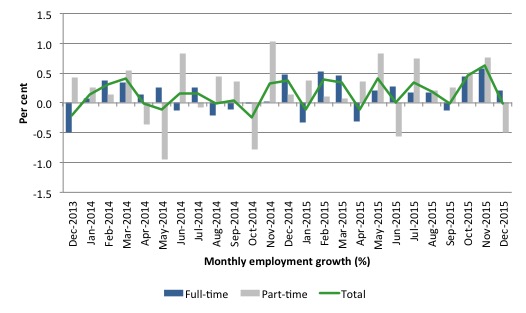
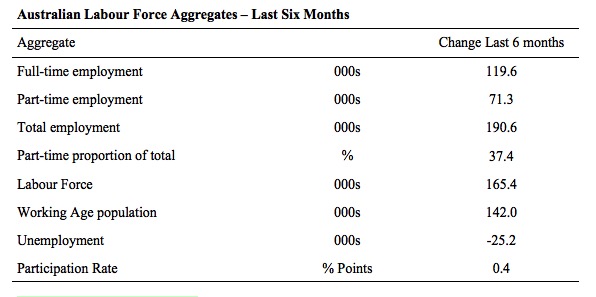
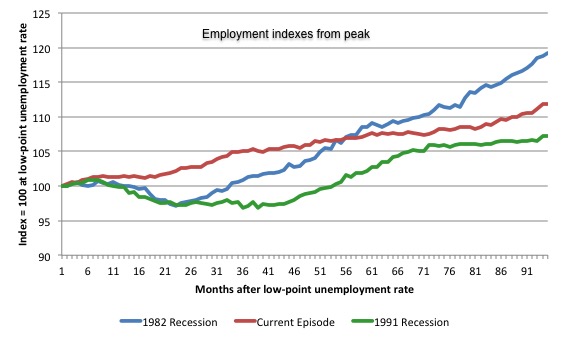

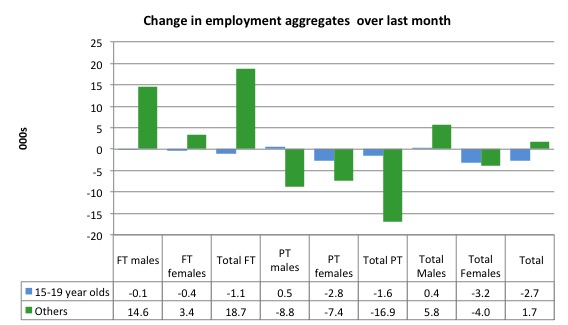
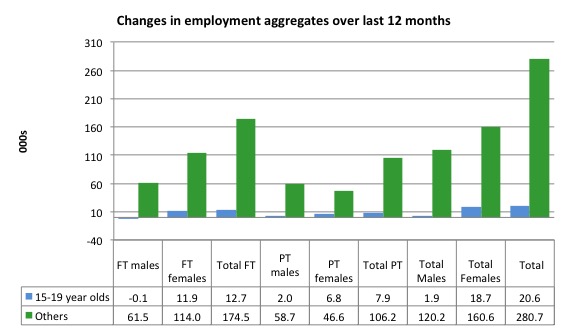


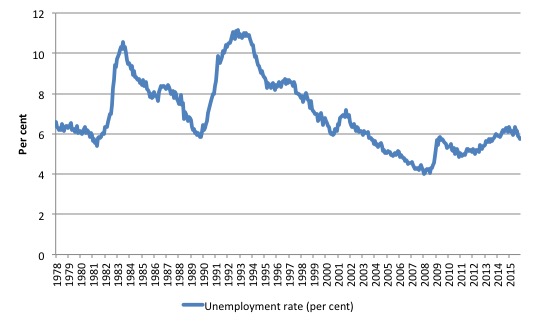

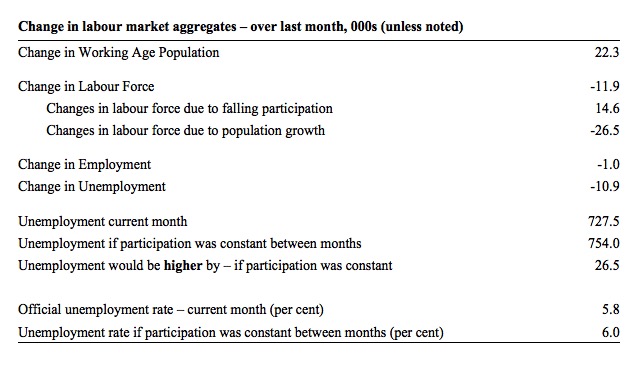
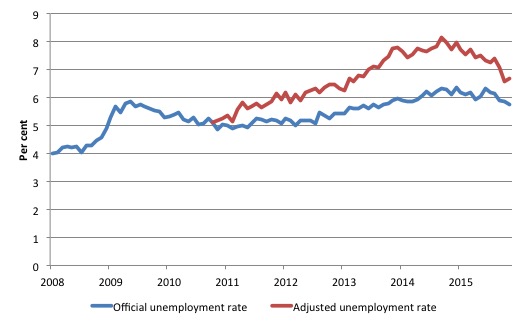
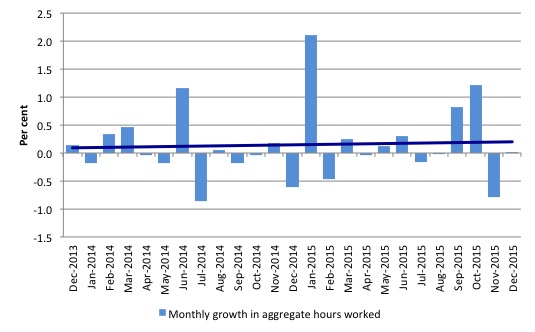
The job market is clearly going nowhere but mainstream economic commentary talked of good numbers.